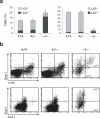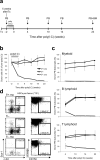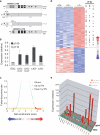ADAR1 is essential for the maintenance of hematopoiesis and suppression of interferon signaling
- PMID: 19060901
- PMCID: PMC2701568
- DOI: 10.1038/ni.1680
ADAR1 is essential for the maintenance of hematopoiesis and suppression of interferon signaling
Erratum in
- Nat Immunol. 2009 May;10(5):551
Abstract
The deaminase ADAR1 edits adenosines in nuclear transcripts of nervous tissue and is required in the fetal liver of the developing mouse embryo. Here we show by inducible gene disruption in mice that ADAR1 is essential for maintenance of both fetal and adult hematopoietic stem cells. Loss of ADAR1 in hematopoietic stem cells led to global upregulation of type I and II interferon-inducible transcripts and rapid apoptosis. Our findings identify ADAR1 as an essential regulator of hematopoietic stem cell maintenance and suppressor of interferon signaling that may protect organisms from the deleterious effects of interferon activation associated with many pathological processes, including chronic inflammation, autoimmune disorders and cancer.
Figures





Comment in
-
A new function for the RNA-editing enzyme ADAR1.Nat Immunol. 2009 Jan;10(1):16-8. doi: 10.1038/ni0109-16. Nat Immunol. 2009. PMID: 19088736 Free PMC article.
Similar articles
-
A new function for the RNA-editing enzyme ADAR1.Nat Immunol. 2009 Jan;10(1):16-8. doi: 10.1038/ni0109-16. Nat Immunol. 2009. PMID: 19088736 Free PMC article.
-
ADAR1 is required for hematopoietic progenitor cell survival via RNA editing.Proc Natl Acad Sci U S A. 2009 Oct 20;106(42):17763-8. doi: 10.1073/pnas.0903324106. Epub 2009 Oct 2. Proc Natl Acad Sci U S A. 2009. PMID: 19805087 Free PMC article.
-
Adenosine-to-inosine RNA editing by ADAR1 is essential for normal murine erythropoiesis.Exp Hematol. 2016 Oct;44(10):947-63. doi: 10.1016/j.exphem.2016.06.250. Epub 2016 Jul 1. Exp Hematol. 2016. PMID: 27373493 Free PMC article.
-
Tipping the balance: antagonism of PKR kinase and ADAR1 deaminase functions by virus gene products.J Interferon Cytokine Res. 2009 Sep;29(9):477-87. doi: 10.1089/jir.2009.0065. J Interferon Cytokine Res. 2009. PMID: 19715457 Free PMC article. Review.
-
A-to-I RNA editing and hematopoiesis.Exp Hematol. 2024 Nov;139:104621. doi: 10.1016/j.exphem.2024.104621. Epub 2024 Aug 24. Exp Hematol. 2024. PMID: 39187172 Review.
Cited by
-
Heterogeneous RNA editing and influence of ADAR2 on mesothelioma chemoresistance and the tumor microenvironment.Mol Oncol. 2022 Dec;16(22):3949-3974. doi: 10.1002/1878-0261.13322. Epub 2022 Oct 31. Mol Oncol. 2022. PMID: 36221913 Free PMC article.
-
Adar-mediated A-to-I editing is required for embryonic patterning and innate immune response regulation in zebrafish.Nat Commun. 2022 Sep 20;13(1):5520. doi: 10.1038/s41467-022-33260-6. Nat Commun. 2022. PMID: 36127363 Free PMC article.
-
Mouse models for Aicardi-Goutières syndrome provide clues to the molecular pathogenesis of systemic autoimmunity.Clin Exp Immunol. 2014 Jan;175(1):9-16. doi: 10.1111/cei.12147. Clin Exp Immunol. 2014. PMID: 23713592 Free PMC article. Review.
-
Targeting innate immunity for tuberculosis vaccination.J Clin Invest. 2019 Sep 3;129(9):3482-3491. doi: 10.1172/JCI128877. J Clin Invest. 2019. PMID: 31478909 Free PMC article. Review.
-
ADAR1 function affects HPV replication and is associated to recurrent human papillomavirus-induced dysplasia in HIV coinfected individuals.Sci Rep. 2019 Dec 27;9(1):19848. doi: 10.1038/s41598-019-56422-x. Sci Rep. 2019. PMID: 31882741 Free PMC article.
References
-
- Levanon EY, et al. Systematic identification of abundant A-to-I editing sites in the human transcriptome. Nature biotechnology. 2004;22:1001–1005. - PubMed
Publication types
MeSH terms
Substances
Associated data
- Actions
Grants and funding
LinkOut - more resources
Full Text Sources
Other Literature Sources
Medical
Molecular Biology Databases

